Trees Birds Mammals Fish Amphibians Reptiles
Wild Algarve
Bookshop
Auricularia auricula-judae (Bull.) Wettst. - Jelly Ear Fungus
Phylum: Basidiomycota - Class: Agaricomycetes - Order: Auriculariales - Family: Auriculariaceae
Distribution - Taxonomic History - Etymology - Identification - Culinary Notes - Reference Sources
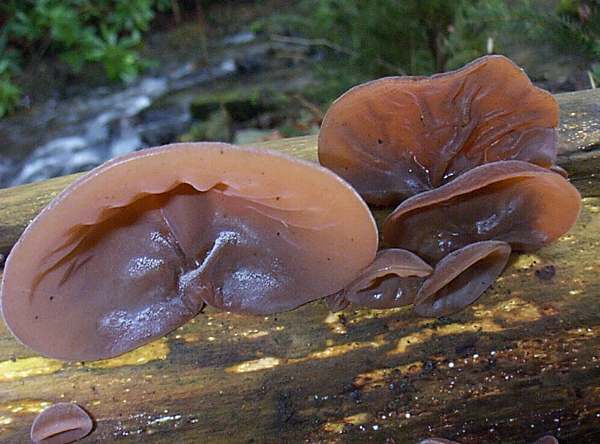
Auricularia auricula-judae, the Jelly Ear Fungus,
is mainly seen in winter and spring. It grows mainly on dead elder trees and on
fallen branches, but occasionally you may also find it growing on other kinds of hardwood.
The so-called Jelly Fungi are not really a taxonomic group but more a rag-tag of basidiomycetes with jelly-like textures, although few are a soft as the jelly we eat with custard. Many are capable of reconstituting and continuing to produce spores when wetted after desiccation.
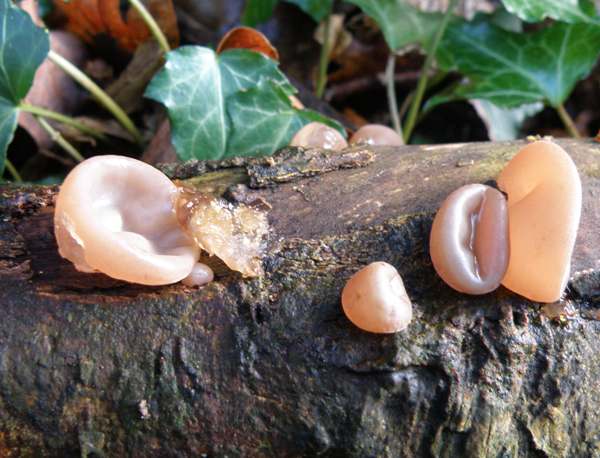
The Jelly Ear fungi shown above are very pale young specimens emerging from a branch that has fallen from a Beech tree.
Distribution
Fairly frequent in Britain and Ireland as well as in most countries of mainland Europe and parts of Asia and North America, the Jelly Ear fungus
is seen mainly, but certainly not exclusively, on dead Elder wood in damp, shady locations. This fungus is also found in many parts of Asia and in Australia.
Taxonomic history
The Jelly Ear Fungus was described scientifically in 1789 by Jean Baptiste François (Pierre) Bulliard, who named it Tremella auricula-judae. After several changes of genus this fungus was transferred into its present genus in 1897 by Austrian botanist-mycologist Richard Wettstein (1863-1931).
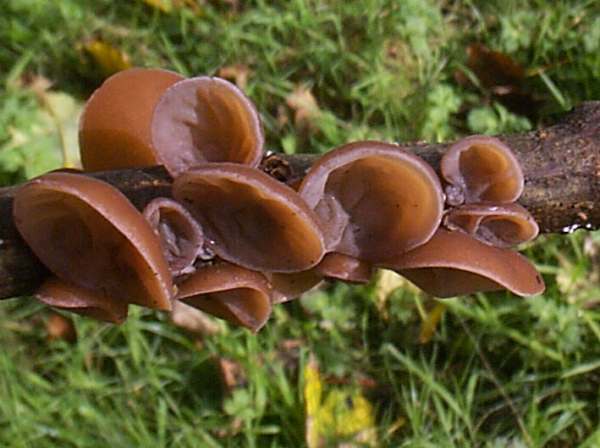
Among the many synonyms that this ubiquitous woodland fungus has gathered are Tremella auricula L., Peziza auricula-judae (Bull.) Bolton, Tremella auricula-judae Bull., Exidia auricula-judae (Bull.) Fr., Hirneola auricula-judae (Bull.) Berk., Auricularia auricula-judae var. lactea Quel., Auricularia auricula (L.) Underw., and Hirneola auricula-judae var. lactea (Quel.) D.A. Reid.
Etymology
Auricula is a Latin word meaning ear. Judae means Judas, the Jew who it is said betrayed Jesus. Older field guides may list this species under the common name Jew's Ear fungus, a derogatory term that I will mention only once in case you see it either online or in an earlier printed publication and wonder which species it refers to. Other, older common names for this species include Wood Ear and Judas' Ear - the latter a reference to the belief that Judas Iscariot hanged himself on an Elder tree in shame after betraying Jesus Christ to his executioners. The legend, which dates back more than 400 years, suggests that the fulgal 'ears' that emerge from Elder wood are visible residues of Judas' tormented spirit.
Identification guide
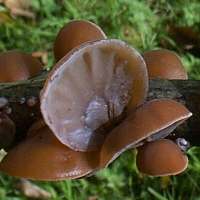
|
Fruitbody
The outer surface of the lobed fruitbody is
tan-brown with a purple tinge and covered in a fine greyish velvety down.
The inner surface is smooth. If you are not put off by the strange appearance and sombre colour of
the Jelly Ear fungus, it is in fact edible when cooked and very popular in some
eastern countries. I have tried it, and the texture is quite pleasant but I cannot detect any flavour at all. Individual lobes of Auricularia auricula-judae grow to between 3 and 10cm across. |
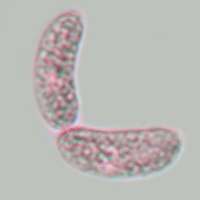 |
Spores
Sausage shaped (allantoid), 16-18 x 6-8µm.
Spore print
White. |
Odour/taste |
Not distinctive. |
Habitat & Ecological role |
Saprobic, on dead and decaying Elder wood; also on the
branches of Elder trees that are dying, and sometimes as a weak parasite on the trunks of
living elders. It is rare but not unknown to find this fungus on other
kinds of broad-leaf trees including Sycamore, Beech and Ash. In Australia this fungus grows also on Eucalyptus trees and fallen branches. |
Season |
Auricularia auricula-judae can be seen throughout the year, but it is most prevalent in late
summer and autumn. |
Similar species |
Auricularia mesenterica, commonly known as Tripe Fungus or
Grey Brain Fungus, is
the type species of the genus Auricularia; its fruitbodies are smaller, greyish-brown and form bracket-like tiers on dead broad-leaf
timber. It is more 'hairy' and much paler than Jelly Ear Fungus. |
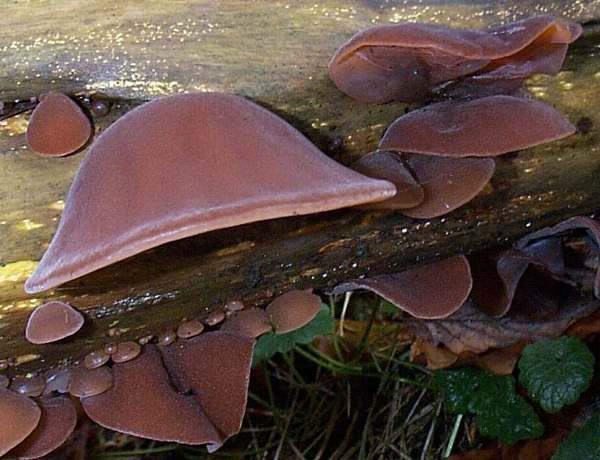
Culinary Notes
Jelly Ear is sometimes used in cookery, where it provides an interesting texture but is nothing special in terms of flavour. Young fresh fruitbodies (above) are generally considered the best. A similar and closely-related species is a very popular edible fungus in the Far East, and most notably in China where it is also used in medicine. I can detect no real flavour in this mushroom, but its texture in a mushroom mix is quite pleasant.
Reference Sources
Fascinated by Fungi, 2nd Edition, Pat O'Reilly 2016, reprinted by Coch-y-bonddu Books in 2022.
Brian P. Looney, Joshua M. Birkebak, and P. Brandon Matheny (2013). Systematics of the genus Auricularia with an emphasis on species from the southeastern United States; North American Fungi Vol 8, No 6, pp 1-25.
Dictionary of the Fungi; Paul M. Kirk, Paul F. Cannon, David W. Minter and J. A. Stalpers; CABI, 2008
Taxonomic history and synonym information on these pages is drawn from many sources but in particular from the British Mycological Society's GB Checklist of Fungi.
Top of page...
Fascinated by Fungi. Back by popular demand, Pat O'Reilly's best-selling 450-page hardback book is available now. The latest second edition was republished with a sparkling new cover design in September 2022 by Coch-y-Bonddu Books. Full details and copies are available from the publisher's online bookshop...